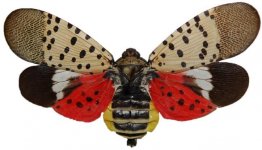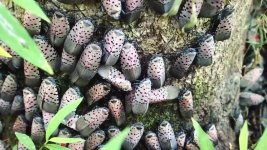Looks like a pretty moth but it is an invasive species that can destroy crops, trees and shrubs. It has been moving westward from the east coast where it was accidentally imported in some shipping containers. Probably in Ohio and possibly southeast Michigan. It is definitely in most of Pennsylvania and it is causing problems.


This alert is from the AG dept of Pennsylvania but it is all over the east and moving west. Ohio should be on high alert for this. Ditto SE Michigan.

 www.agriculture.pa.gov
www.agriculture.pa.gov
The spotted lanternfly causes serious damage including oozing sap, wilting, leaf curling and dieback in trees, vines, crops and many other types of plants. In addition to plant damage, when spotted lanternflies feed, they excrete a sugary substance, called honeydew, that encourages the growth of black sooty mold. This mold is harmless to people however it causes damage to plants. In counties infested and quarantined for spotted lanternfly, residents report hundreds of these bad bugs that affect their quality of life and ability to enjoy the outdoors during the spring and summer months. Spotted lanternflies will cover trees, swarm in the air, and their honeydew can coat decks and play equipment.
In addition to damaging trees and affecting quality of life, the spotted lanternfly is a huge threat to Pennsylvania agriculture industry. The economic impact could total in the hundreds of millions of dollars and hundreds of thousands of jobs for those in the grapes, apple, hops, and hardwood industries.
PDA and USDA follow up with all reports of Spotted Lanternfly in Pennsylvania counties that are not quarantined for spotted lanternfly to discover, contain and limit further spread of the invasive insect.
They also use all the reported data from across the Commonwealth to better understand the spread and numbers of the invasive insect, which directly contributes to when and where they treat.


This alert is from the AG dept of Pennsylvania but it is all over the east and moving west. Ohio should be on high alert for this. Ditto SE Michigan.

Spotted Lanternfly Alert
 www.agriculture.pa.gov
www.agriculture.pa.gov
Spotted Lanternfly Alert
The spotted lanternfly causes serious damage including oozing sap, wilting, leaf curling and dieback in trees, vines, crops and many other types of plants. In addition to plant damage, when spotted lanternflies feed, they excrete a sugary substance, called honeydew, that encourages the growth of black sooty mold. This mold is harmless to people however it causes damage to plants. In counties infested and quarantined for spotted lanternfly, residents report hundreds of these bad bugs that affect their quality of life and ability to enjoy the outdoors during the spring and summer months. Spotted lanternflies will cover trees, swarm in the air, and their honeydew can coat decks and play equipment.
In addition to damaging trees and affecting quality of life, the spotted lanternfly is a huge threat to Pennsylvania agriculture industry. The economic impact could total in the hundreds of millions of dollars and hundreds of thousands of jobs for those in the grapes, apple, hops, and hardwood industries.
Identification
The spotted lanternfly adult is approximately 1" long and 1/2" wide at rest. The forewing is grey with black spots and the wings tips are reticulated black blocks outlined in grey. The hind wings have contrasting patches of red and black with a white band. The legs and head are black; the abdomen is yellow with broad black bands. Immature stages are black with white spots, and develop red patches as they grow.What happens after you report spotted lanternfly?
Both the PDA and the U.S. Department of Agriculture (USDA) value all public reports for spotted lanternfly, but they are not able to respond to every report as they receive, on average, more than 1,500 reports a week.PDA and USDA follow up with all reports of Spotted Lanternfly in Pennsylvania counties that are not quarantined for spotted lanternfly to discover, contain and limit further spread of the invasive insect.
They also use all the reported data from across the Commonwealth to better understand the spread and numbers of the invasive insect, which directly contributes to when and where they treat.


